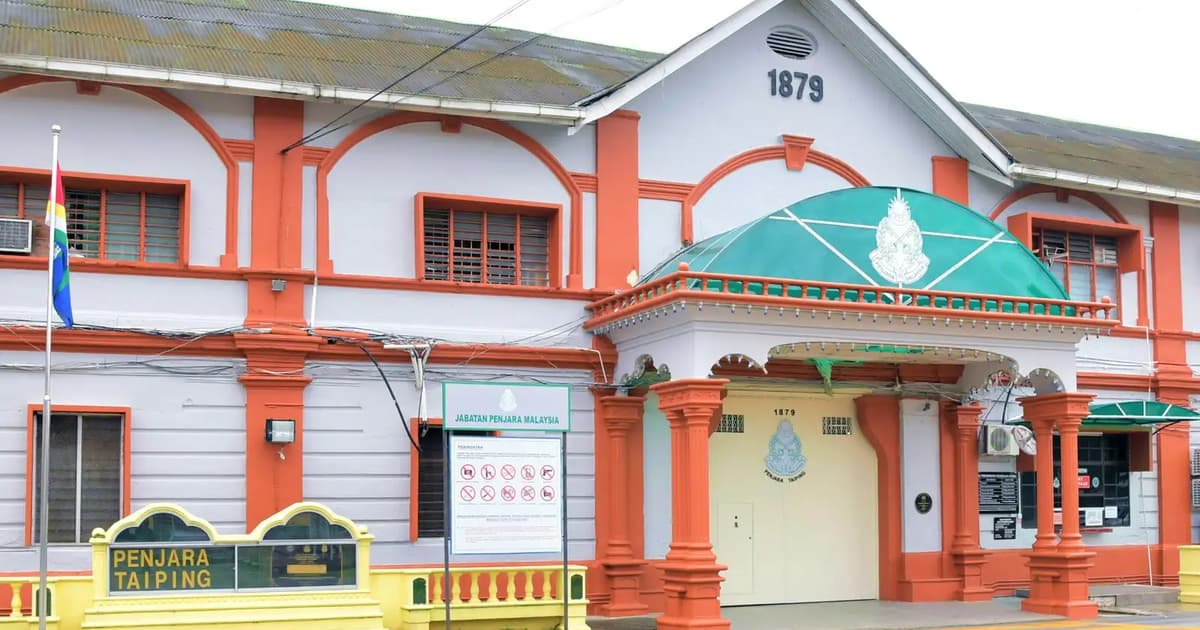
A prison is not a building or institution that elicits pride. It is largely forgotten, as are its prisoners, by society which sees it as just a place to hold criminals and trouble makers.
Perhaps the only place where residents actually take some pride in their prison building is Taiping, for the Taiping Prison is the oldest in the country. It is proudly shown off to tourists as one of the many firsts in Taiping.
Opened in 1879, the prison was built of brick and wood by the British on some 5,100 hectares of land and fenced off with a 9-foot wooden barricade. Interestingly, it was constructed by convicts from India to initially house warring Chinese secret society elements and guarded by local Malays and Sikhs from India.
But even though they take pride in the prison being the first in the country, residents take it for granted and it hardly figures in their conversations.
It is a truism that we tend to pay attention to something or other – like the prison – only when something untoward happens – such as a prison breakout.
Or, as happened in the Taiping Prison on Jan 17, where a standoff between prisoners who had just been transferred from the Batu Gajah Prison and warders over moving into a block which inmates claimed was in bad condition resulted in physical violence.
The ongoing Human Rights Commission of Malaysia’s (Suhakam) public inquiry into allegations that more than 100 inmates were assaulted by about 60 prison warders during the relocation exercise within the walls of the prison which led to the death of one inmate and injury to several others has thrown the spotlight on the Taiping Prison and, I would argue, the prison system in general.
The inquiry, which has yet to conclude, has opened up the proverbial can of worms and points to a host of problems afflicting not just the Taiping Prison but the entire prison system, including facilities available and the training given to warders.
We will only know at the conclusion of the public inquiry if there was an attempt at covering up the matter.
One reason I say this is because most Malaysians came to know of the “rioting” only after the inquiry started in June, not in January.
Another is the press statement released on Feb 13 by Suhakam condemning “the obstruction faced by its officers while conducting an official investigation into alleged human rights violations involving inmates at Taiping Prison on 17 January 2025”.
Suhakam informed the Prisons Department of its intention to record the testimony of an inmate at the Batu Gajah prison.
Suhakam officers, after receiving a letter from the Prisons Department headquarters allowing the visit, went to the Batu Gajah prison only to be “unjustly denied access to the said inmate. According to the Prison Department, Suhakam must postpone the inquiry pending an ongoing police investigation”.
Suhakam was informed that its scheduled investigation visits to Taiping Prison from 12 to 14 Feb 2025 had also been prohibited for the same reason.
The national rights body described the obstruction as “a grave violation of the law”, adding that it undermined Suhakam’s legal obligations. It noted that under the law, Suhakam was empowered “to visit places of detention, institutions and other places without any refusal when Suhakam complies with the provisions of written laws”.
“In its 25 years of experience, there were many concurrent investigations by both Suhakam and the police in prison including death in custody cases. There was no issue or problem due to the concurrent investigations,” Suhakam said.
Yet another reason for a possible cover-up or down-play attempt is the admission to the inquiry panel by deputy superintendent Khairul Esmail Zawawi of the Taiping Prison that he had filed a false police report on the alleged assault of inmates by prison warders by claiming that the 100-plus inmates were the aggressors.
Also, members of the inquiry panel led by Suhakam chairman Hishamudin Yunus have noted that some of the prison officials were evasive in their replies.
Interestingly, investigating officer ASP Siti Nor Rasyidah M. Nadzri told the inquiry on Sept 2 that although police had classified the case as “high-profile”, till date no arrest had been made despite police questioning 214 witnesses.
She added that she was transferred to the state’s traffic department on May 5 and that she was informed only last week that another officer would be taking over the case.
She also told the panel that she had to wait several days to receive the closed-circuit television (CCTV) recording of the incident at the Taiping Prison.
I note from the questions raised and remarks made during the inquiry so far that the CCTV recording has been very helpful in the search for the truth of what transpired.
Several prison officers said the warders’ high stress levels and their inability to handle their emotions had contributed to the violence.
I was shocked to learn that several prisons, including that in Taiping, still use the bucket system of human waste removal.
We say we live in a modern Malaysia with some of the best infrastructure and facilities in the world, yet the bucket system is still in use in some prisons.
I wonder if it is in use elsewhere.
On Sept 3, deputy commissioner of prisons Hafidz Othman admitted at the inquiry that facilities in several Malaysian prisons did not meet modern global standards.
He said the prisons in Taiping, Seremban, Penang, Batu Gajah and Alor Setar were built during the pre-war period and with the main purpose of punishing convicts for wrongdoing. Today, the emphasis is on a more humane approach with basic amenities, healthcare and space for activities provided.
One such facility that needed upgrading, he said, was the human waste disposal system. He said bucket toilets were placed inside the cells and the waste disposed of manually each morning.
“This is the biggest problem for us. The public works department (JKR) has advised us that it is not feasible to build toilets inside the cells as the building is old and not safe,” Hafidz said.
PWD surveyor Azlan Abdul Aziz told the public inquiry that the JKR had previously recommended that toilets be built outside the buildings housing the prison cells but that this was turned down by the prison authorities for “security reasons”.
He also said his team conducted inspections on Blocks B, C and E and the control posts at Taiping Prison in 2022 and recommended that Blocks B and E be left vacant until upgrading work was carried out as both blocks were not safe to be occupied.
It is to be noted that the violence occurred during a relocation exercise from Hall B to Block E of the prison on Jan 17, with prisoners refusing to move into Block E.
Azlan also told the public inquiry that as Taiping Prison had been classified as a heritage building, the PWD or contractors had to get the consent of the heritage commissioner before they could carry out any upgrading work.
I wonder what else will be revealed over the coming days.
Whatever they are, it is clear that the Prisons Department has much to rectify.
The Suhakam public inquiry must be seen as an opportunity for the government to find out the problems faced by prisons and work to fix the prisons system. Its recommendations must not be filed away but must be acted upon.
The views expressed are those of the writer and do not reflect those of FMT.






